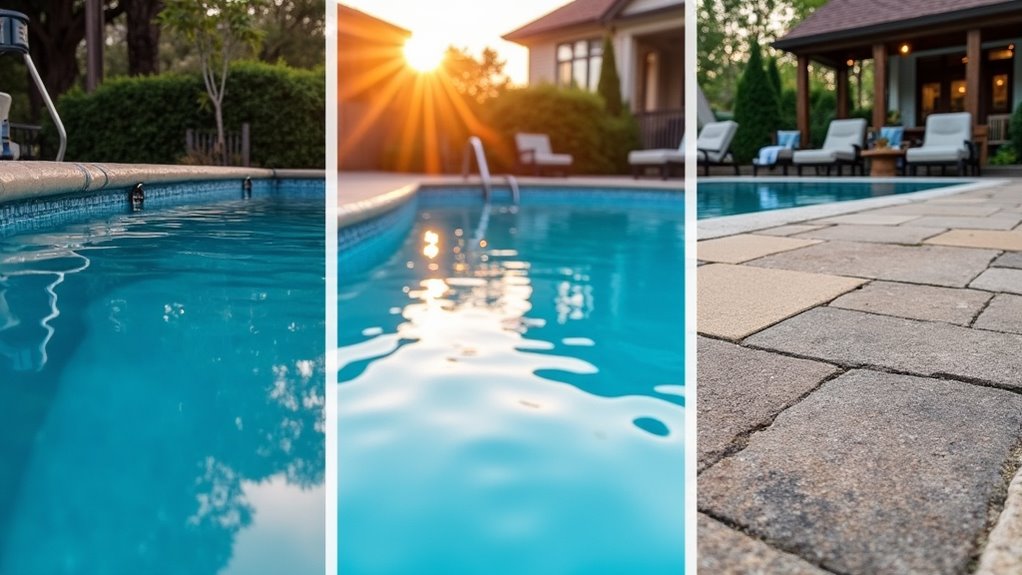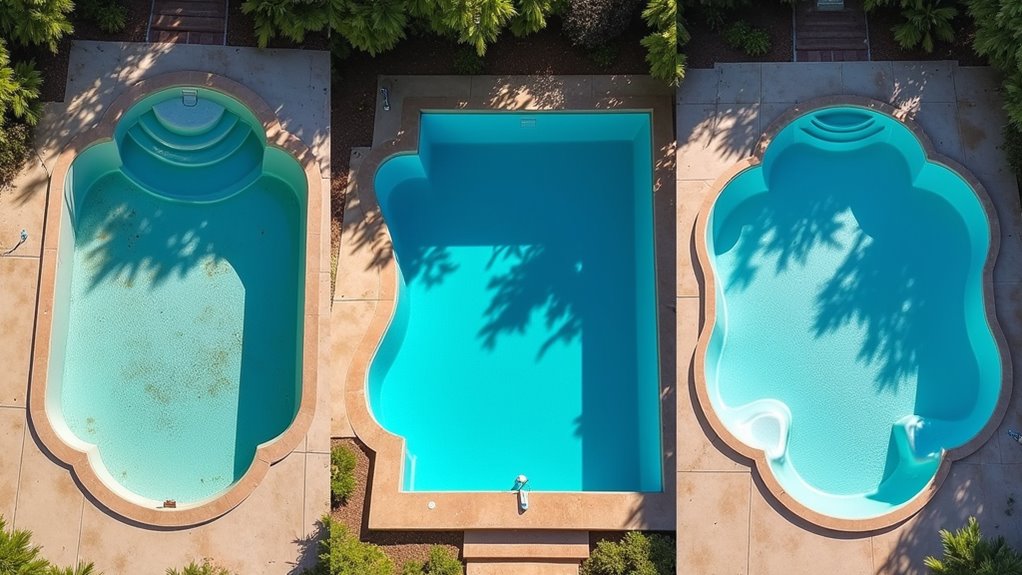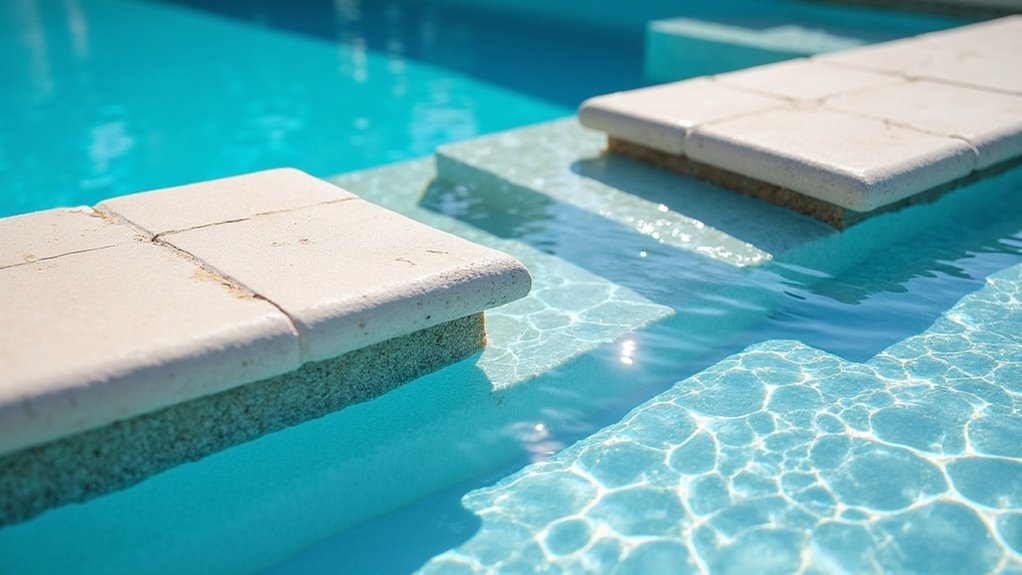Fiberglass pools will typically last 25-35 years with minimal maintenance, offering better longevity than vinyl pools that require liner replacement every 5-9 years. While concrete pools can survive 30-50 years, they’ll need resurfacing every 10-15 years, making them more maintenance-intensive. Your fiberglass pool’s durability depends on factors like soil composition, climate, and water chemistry management. Understanding these key elements will help you enhance your pool’s lifespan and protect your investment.
Key Takeaways
- Fiberglass pools typically last 25-35 years, vinyl pools around 20 years, and concrete pools 30-50 years with proper maintenance.
- Vinyl pools require liner replacement every 5-9 years, while fiberglass maintains structural integrity without major replacements.
- Concrete pools need resurfacing every 10-15 years, but fiberglass pools require minimal maintenance and resist algae growth.
- Fiberglass pools cost less long-term due to lower maintenance needs compared to vinyl’s recurring liner replacements.
- Fiberglass pools perform better in freeze-thaw conditions and maintain structural integrity longer than both vinyl and concrete alternatives.
Understanding the Basic Lifespan of Each Pool Type

When evaluating pool construction options, understanding the expected lifespan of each material is essential for making an informed investment decision. Fiberglass pools typically last 25-35 years, with many lasting even longer when properly maintained. One of the key fiberglass advantages is its non-porous surface, which resists algae growth and chemical deterioration.
Vinyl liner pools have a shorter lifespan, requiring liner replacement every 5-9 years. Among vinyl drawbacks, the liner can tear from sharp objects and deteriorate from UV exposure. Concrete pools generally last 30-50 years but need resurfacing every 10-15 years due to surface roughening and crack development.
You’ll need to factor these longevity differences into your comprehensive cost analysis, as maintenance and replacement expenses greatly impact the total investment over time.
Key Factors That Impact Pool Durability

Several critical variables determine how long your pool will maintain its structural integrity and aesthetic appeal. The underlying soil composition and groundwater conditions directly affect your pool’s stability, regardless of material type. Proper construction techniques, including adequate soil compaction and precise installation procedures, play an essential role in preventing structural issues.
Material strength varies greatly among pool types, with fiberglass offering uniform shell thickness, concrete providing customizable structural support, and vinyl requiring careful liner maintenance. You’ll need to evaluate your local climate, as freeze-thaw cycles can stress concrete, while UV exposure affects vinyl and fiberglass surfaces differently. The quality of your pool’s water chemistry management and regular maintenance schedule will also considerably impact its longevity, particularly in preventing material degradation and surface finish deterioration.
The Long-Term Structure of Fiberglass Pools

Building on the importance of material durability, fiberglass pools stand out for their impressive structural longevity. The pool structure consists of multiple layers of fiberglass and resin, creating a single, seamless shell that’s resistant to warping, cracking, and separation.
One of the key fiberglass benefits is its ability to flex without breaking, allowing it to adapt to ground movement and seasonal changes. Unlike concrete pools that can develop structural cracks, or vinyl liners that require regular replacement, fiberglass maintains its integrity for decades. You’ll find that the gelcoat surface layer, reinforced by subsequent layers of fiberglass, creates a watertight barrier that prevents water penetration and structural deterioration. This multi-layer construction guarantees your pool’s shell remains stable and functional, typically lasting 25-30 years with proper maintenance.
Maintenance Requirements and Their Effect on Longevity
Although all pool types require regular maintenance, fiberglass pools demand notably less upkeep than their vinyl and concrete counterparts. You’ll spend remarkably less time on pool cleaning and surface repairs with a fiberglass pool, which helps preserve its structural integrity for decades.
- While concrete pools need acid washing and resurfacing every 7-10 years, costing thousands of dollars, your fiberglass pool’s gelcoat surface remains smooth and intact with basic maintenance.
- Unlike vinyl liners that require replacement every 5-9 years due to tears and deterioration, your fiberglass shell maintains its shape and durability without replacements.
- You’ll save substantial time on chemical balancing since fiberglass’s non-porous surface resists algae growth, reducing the frequency of cleaning and chemical treatments compared to concrete and vinyl options.
Weather and Environmental Impacts on Different Pool Materials
The long-term durability of your pool investment depends heavily on how well different materials withstand environmental stresses and weather conditions.
Fiberglass pools demonstrate superior resistance to weather effects, maintaining structural integrity through freeze-thaw cycles and temperature extremes. You’ll find they don’t crack or warp like concrete pools, which can develop stress fractures from ground movement and seasonal changes. Environmental factors such as soil chemistry and groundwater pressure affect each material differently. Vinyl liners become brittle from UV exposure and can tear from environmental debris.
In regions with frequent temperature fluctuations, concrete pools often require more repairs due to expansion and contraction damage. Your fiberglass pool shell, however, flexes slightly with ground movement, while its gelcoat surface resists chemical degradation and algae growth regardless of climate conditions.
Cost Analysis: Initial Investment vs. Lifetime Value
When comparing pool materials, three distinct cost tiers emerge: vinyl as the lowest initial investment at $25,000-35,000, fiberglass in the middle range at $45,000-65,000, and concrete commanding the highest upfront cost at $50,000-100,000.
While initial costs may steer you in the direction of vinyl, consider these lifetime value factors:
- You’ll need to replace a vinyl liner every 5-9 years at $4,500-7,000 per replacement
- Concrete pools require resurfacing every 10-15 years, costing $10,000-20,000 each time
- Fiberglass pools deliver long term savings through minimal maintenance and a 25+ year gelcoat lifespan
When calculating total ownership costs over 25 years, fiberglass often emerges as the most economical choice, despite its middle-range initial investment. The reduced chemical requirements and lower maintenance expenses contribute greatly to this cost advantage.
Common Signs of Pool Deterioration and Aging
Each swimming pool material exhibits distinct warning signs as it matures, with deterioration patterns varying considerably between vinyl, fiberglass, and concrete surfaces. You’ll notice vinyl liners becoming brittle, fading, and developing tears at the seams, typically within 5-10 years. In fiberglass pools, watch for spider cracks in the gel coat and potential fading, though these rarely affect structural integrity.
Concrete pools show the most visible aging through surface etching, rough spots, and cracks that can compromise the pool’s structure. You’ll also spot calcium deposits and algae stains more frequently on concrete surfaces. When inspecting your pool, pay attention to water loss, as all three types can develop leaks through different mechanisms – liner separations in vinyl, plumbing issues in fiberglass, and structural cracks in concrete.
Extending Your Pool’s Lifespan Through Proper Care
Regular maintenance serves as the cornerstone of maximizing your pool’s longevity, regardless of its construction material. Through consistent pool cleaning and regular inspections, you’ll identify potential issues before they escalate into costly repairs.
Proactive pool maintenance isn’t just about aesthetics – it’s about protecting your investment and catching small problems before they become major headaches.
- Maintain proper chemical balance daily – this prevents surface deterioration, extends your pool’s finish, and protects swimmers from harmful bacteria
- Schedule professional inspections twice yearly – experts can spot hairline cracks, equipment wear, and structural concerns that aren’t visible to untrained eyes
- Clean your pool’s filtration system weekly – this prevents strain on the pump, guarantees proper water circulation, and removes debris that could cause long-term damage
Following these critical maintenance steps won’t just preserve your pool’s aesthetics – it’ll protect your investment and greatly extend its functional lifespan.
Making the Right Choice for Your Climate and Lifestyle
Since climate conditions greatly impact pool performance and durability, choosing the right pool material requires careful consideration of your local weather patterns and intended usage. Your pool selection should align with both environmental factors and lifestyle compatibility.
| Factor | Best Material | Considerations |
|---|---|---|
| Freezing Climate | Fiberglass | Superior freeze-thaw resistance |
| Hot Climate | Concrete | Excellent heat tolerance |
| Coastal Areas | Fiberglass | Salt-resistant properties |
| High Usage | Concrete | Maximum durability |
| Budget Focus | Vinyl | Lower initial cost |
If you’re in an area with extreme temperature fluctuations, fiberglass offers the most versatility. For heavy entertaining and frequent swimming, concrete’s durability makes it ideal. Vinyl works well in moderate climates where cost-effectiveness is priority. Consider your family’s swimming habits, maintenance preferences, and regional weather patterns when making your final decision.
Frequently Asked Questions
Can a Fiberglass Pool Shell Be Recycled When It Reaches End-Of-Life?
You’ll find limited recycling options for fiberglass pool shells due to their composite materials and chemical resins. While technically recyclable, few facilities are equipped to process these large, complex structures. The environmental impact of disposal is significant since most shells end up in landfills. Some specialized companies may grind the material for use in other products, but you’ll need to research local facilities that handle fiberglass composite recycling.
Does Pool Shape Affect the Longevity of Different Pool Materials?
Pool shape does influence material durability and maintenance requirements. You’ll find that sharp corners and complex designs in concrete pools can develop stress cracks more easily than curved shapes. With vinyl liners, tight corners increase the risk of wrinkles and tears, reducing longevity. Fiberglass pools are pre-manufactured with rounded designs specifically to optimize structural integrity. For all materials, gentle curves and gradual shifts will typically extend your pool’s lifespan and lessen maintenance needs.
How Do Salt Water Systems Impact Different Types of Pool Materials?
When you’re using saltwater systems, material compatibility is vital for your pool’s longevity. Fiberglass resists saltwater corrosion exceptionally well, making it an ideal choice. However, you’ll need to monitor concrete pools more closely as salt can gradually erode the surface and affect steel reinforcements. Vinyl liners are moderately resistant but may experience accelerated aging. It’s important to maintain proper salt levels and regularly inspect your pool’s surfaces regardless of material type.
Can You Change a Vinyl Pool to Fiberglass Later?
You can’t directly convert a vinyl pool to fiberglass, as these pools have fundamentally different structural designs. While pool renovation options exist, replacing a vinyl liner pool with fiberglass would require completely demolishing the existing structure and starting fresh. If you’re considering a vinyl pool conversion, it’s more cost-effective to either maintain your current vinyl system or completely rebuild with a new fiberglass shell installation from scratch.
Do Insurance Rates Differ Between Fiberglass, Vinyl, and Concrete Pools?
You’ll find that insurance rates can vary between pool types, with material durability being a key insurance factor. Concrete pools often command higher premiums due to their potential for structural issues and costly repairs. Fiberglass pools typically offer lower rates because they’re more stable and resistant to damage. Vinyl pools may have slightly higher premiums due to liner replacement risks. It’s best to consult your insurance provider, as rates vary by location and specific circumstances.






